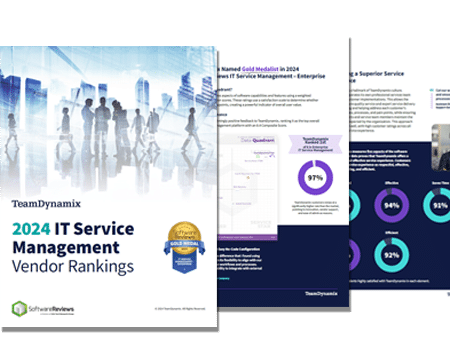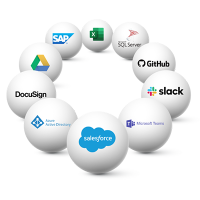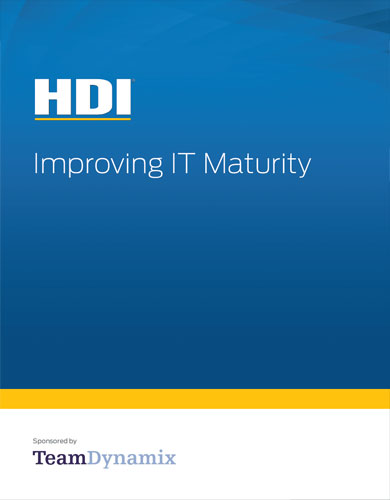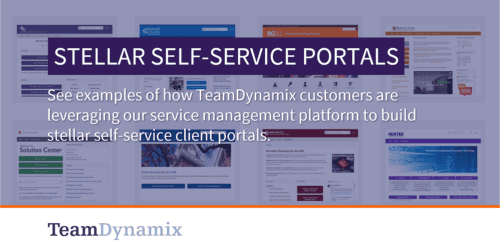
Paving the Way for Better IT Service with the Right ITSM Tool
The construction industry can be very volatile, with a high employee turnover rate due to seasonal fluctuations in the workforce. A key challenge for the

The Info-Tech ranking report offers a unique view of the market based entirely on in-depth customer interviews. Download the Info-Tech ITSM Quadrant and Customer Viewpoint report today.

We’ll show you some of our best situations and show you exactly how to execute them to get immediate results. The best part is, iPaaS tools often feature easy-to-use click and drag functionality, meaning you don’t need a dedicated employee building integrations and workflows.

System Integrators, Value Added Resellers, Technology Providers, and Buying Consortiums can benefit from a partnership with TeamDynamix.

The Info-Tech ranking report offers a unique view of the market based entirely on in-depth customer interviews. Download the Info-Tech ITSM Quadrant and Customer Viewpoint report to gain a better understanding of key vendor strengths and emerging market requirements.
TeamDynamix is well suited for corporations where IT resources are often constrained yet expectations for new tech and high growth are on the rise. For these companies, we offer an easy to use, own, and operate platform that will allow you to follow ITIL4 standards while also incorporating project management for better optimization of resources.
TeamDynamix is well suited for corporations where IT resources are often constrained yet expectations for new tech and high growth are on the rise. For these companies, we offer an easy to use, own, and operate platform that will allow you to follow ITIL4 standards while also incorporating project management for better optimization of resources.





One Easy-To-Use Platform. Tailored For You.
IT leaders at Covenant HealthCare knew their IT department needed a faster, more efficient way to manage service requests and projects. They chose TeamDynamix to be their combined IT Service Management and Project Management solution to help them meet the challenges occurring as a result of the increasing demand for IT support.
“In healthcare, they need quick, fast access — like they are running a kiosk, or at a checkout line,” explains Raymond Hall, the Technology Manager at Covenant HealthCare. “But the amount of data that they need, and the sophistication of the data that they need, is the equivalent of someone sitting down to do a research paper.”
Frank Fear
CIO, Covenant Health

Reliable IT service management is especially critical in a banking environment. The Gratz Bank is using the TeamDynamix platform to gain the visibility they need into technical operations and build sound change management processes. They are even using it outside of IT to help with enterprise service management.

TeamDynamix Ranked #1 in ITSM
ITSM platforms are quickly evolving, download this report to understand key drivers for top of quadrant vendors. Use this guide to help you during your selection process. Download the Info-Tech 2022 ITSM Quadrant and Customer Viewpoint report to gain a better understanding of key vendor strengths and emerging market requirements.
Maturity, as it pertains to IT and IT service management, means the state of people, processes, and technology in the organization, and the achievement of improvement goals based on accepted measurements. Generally, a model is chosen, and assessments are performed, either by the organization itself (self-assessment) or by an auditor from an external organization.
Maturity matters because it shows the capability of IT and IT service management organization to serve as a ready, willing, and able partner to achieve business or organizational goals in a stable and predictable way. In general, states of maturity move from the chaotic to optimized in defined steps according to the model.


Imagine if you could reduce your call volume by 70%.
This is exactly what happened at the University of Wyoming, and this was done while increasing student satisfaction. Building a stellar student portal is the key – one that looks good, is easy to use, contains accurate content, and makes sure your system is indexable, AND accessible with WCAG 2.0/508 compliance.
Supporting and enhancing the ‘student experience’ throughout the student life-cycle (from first contact to becoming alumni) is critical to success in higher education today for both the student and the institution. The student experience encompasses all aspects of student life with academics at the heart of it.






Recently a group of technology leaders from the retail, healthcare, and higher education sectors got together to talk about how they’re approaching digital transformation and building connected enterprises that blend people, processes, and technology.


The construction industry can be very volatile, with a high employee turnover rate due to seasonal fluctuations in the workforce. A key challenge for the

A study from Information Week and TeamDynamix shows companies are looking to invest in IT Service Management (ITSM) software that is simple to administer and

Enterprise Service Management (ESM) is the practice of extending IT Service Management (ITSM) principles beyond the IT department to other areas of an organization. ESM
TeamDynamix’s award-winning SaaS cloud solution offers IT Service and Project Management together on one platform with enterprise integration and automation.
[email protected]
(877) 752-6196
Contact Us
